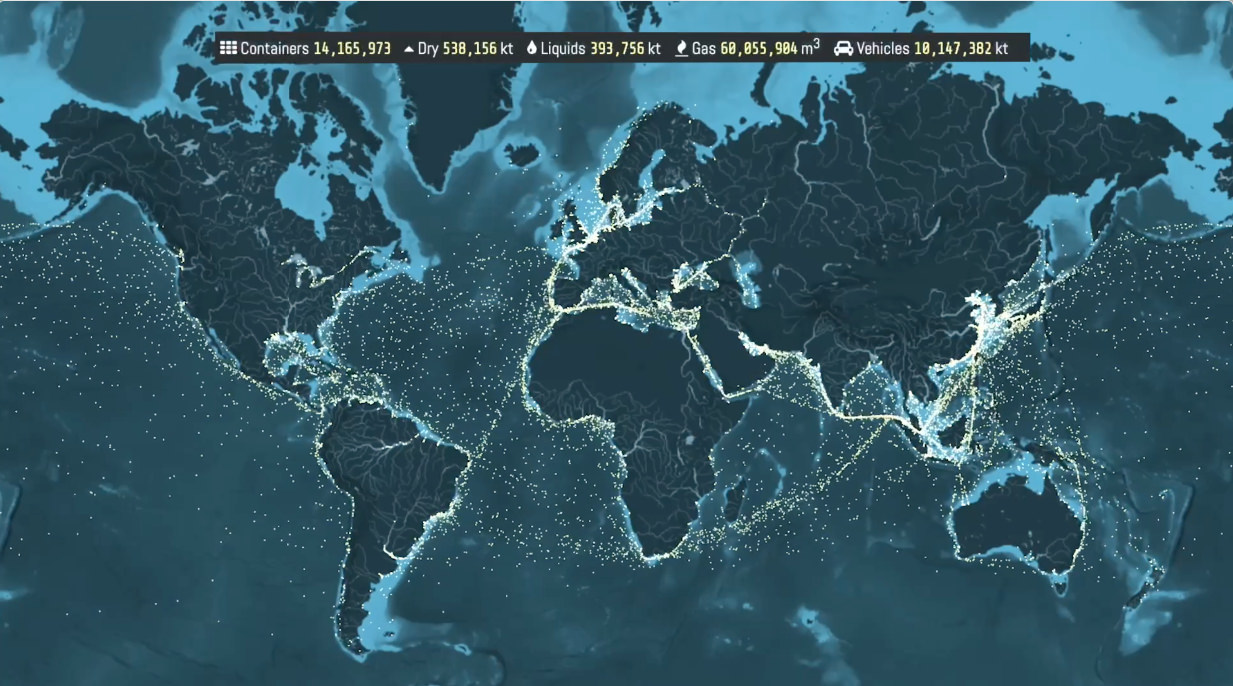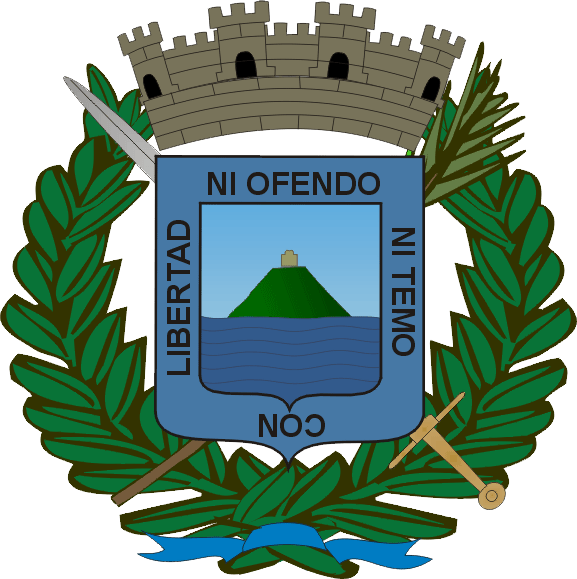Monte Vi de E-0
A cogitation. A contemplation. A meditation.
Inspired by summer-evening sunset views of el Puerto de Montevideo.
The Work
A video installation in a dark rectangle with walls that support excellent audio (no earphones) and deter audio leakage.
Controlled access.
Twenty persons every 30 minutes.
All are free to leave anytime.
As the audience arrives, this video begins on the left wall and plays for 3.5 minutes. Audio fades in easy.
Serious audio.
Then the video dissolves into a linear version that repeats the first video in a complex sequence and duplicates it.
Audio continues.
On the opposite wall:
Two large screens appear, side by side, as a recorded narrator begins a story.
Left screen:
Video visualization of recent international ship traffic.

Right screen:
Slow flow of shipping and trade statistics. And true miniature stories about the industry.
The credits appear on the data screen.
Puerto de Montevideo
22.15 UTC - 02:00, 18.04.2024, 34.54.11 S, 56.11.17 W
Facilities and operations
Katoen Natie
Ship
YM Trust
Owner
Yang Ming Marine Transport Corporation
Flag
Singapore
Builder
Higaki Shipbuilding, 2021
Cargo Capacity
14,000 containers
Route
Round trip, Asia to South America
Camera
(Location: Guru’Guay)
The narration continues for 10 minutes. A West Indian matriarch describes the players in the scene, and explains why the scene exists:
We can’t live without it.
As the narration nears the end, the first screen returns to the original single port view.
The dancing cranes take their final bow.
The End
Requirements
Permission to use Kiln’s shipping data for the world map
Enclosed dark space, 15 x 15 meters
Serious projector and digital screens
Perfect audio
Chairs or benches or pillows
Easy simple entry system
Financial and curatorial support
Good people
Specifications are negotiable, within reason.
Budget
To be determined by location and configuration.
Concept & Production
Vasco Elola & Tom Rieke

Narration
In 1726, Spain defeated Portuguese invaders and created el Puerto de Montevideo.
The official name was a Spanish navigation point. The sixth hill east to west, along a deep natural harbour. Now the blinking beacon in the middle left of the video marks the hill.
Monte de VI de E a O
At first, Montevideo was a small village in Spain’s colonial empire. Soon it became a major international port for tycoons in Amsterdam, London, Lisboa, New York, and Seville.
It also welcomed thousands of Europeans and their African slaves. The Europeans overwhelmed and mostly eradicated the people who lived near the port and in the countryside. Eventually, after many battles and maneuvers, the Europeans created a new nation.
República Oriental del Uruguay
Now, 300 years after the first ships unloaded there, el puerto de Montevideo receives and exports enormous cargos of minerals, energy, food, wine, vehicles, and life’s essentials and luxuries, to and from the Americas, Europe, Asia, and beyond.
It is a major link in the world’s industrial empires.

Katoen Natie was created in Antwerp in 1854, to receive and process cargos of cotton from Europe’s colonial empires.
In English, its name is: Cotton Guild.
En español: Asociación Algodonera.
It slowly expanded to manage imports of jute, coffee, cocoa, wool, rubber, and aluminium from Asia, Africa, the Middle East, and the Americas.
Now, 170 years after it processed its first shipment, Katoen Natie manages ports and trade in 36 countries. It’s a major player in international logistics.
It’s also a major player in international art. Its home office in Antwerp displays works from the company’s collection of 3000 classic and contemporary artworks and objects.
Senior executives work surrounded by art that others can see by appointment only.

YM Trust is owned by Yang Ming Marine Transport Corporation. Since 1972, its fleet has grown from a few ships in its home port, in Taiwan, to 94 huge freight haulers working 24 hours every day in every ocean and major port on earth.
In English, Yang Ming is bright sun.
En español: sol brillante.
Most of Yang Ming’s ships are registered in Liberia. A few in Panamá. A few more in Hong Kong. It’s the ninth-biggest container shipping company in the world.
Near its head office in Taiwan, Yang Ming renovated a 1915 landmark built by the Japan Mailboat Steamship Line in Keelung Harbour. Now it’s the YM Oceanic Culture & Art Museum.
On the third floor, visitors can pretend to navigate a modern container ship in a virtual simulation.
The museum welcomes visitors with a request:
If you are ready, please open up that cargo ship within your heart, and load it with cargo full of maritime knowledge!

Every ship in the world must be registered by a nation. Owners and nations negotiate expensive deals to join flag lists.
Singapore’s Maritime and Port Authority registers more than 4400 ships It is the fifth-biggest ship registry in the world.
One hundred years ago, Singapore was a struggling swamp in the British Empire. Now it’s one of the world’s most successful ports.

Higaki Shipbuilding, 30 km southeast of Hiroshima, is the biggest Japanese shipbuilding company, the fourth biggest in the world. Every year, it buys about the same amount of steel that Toyota buys to make 5.4 million vehicles.
The steel’s basic component is iron ore from the Greater Tom Price mine in Pilbara Western Australia. Tom Price is the seventh-biggest iron mine on earth. It’s owned by Rio Tinto, the second-biggest iron mining conglomerate in the world.
Higaki Shipbuilding is owned and operated by about 100 descendants of Tameji Higaki, who founded the company in 1951. It builds and repairs cargo ships, chemical tankers, liquefied gas carriers, and cement haulers. And it has its own fleet of 150 cargo ships, all leased by shipping companies.
Higaki Shipbuilding’s slogan is:
Go Beyond the Waves

Beyond the waves is beyond reality. It’s not possible to live beyond the waves.
Waves are in us and everywhere around us. Sound waves. Light waves. Atomic waves.
Molecular waves. Radio waves. Cosmic waves. Gravity waves.
Higaki Shipbuilding is a huge conglomeration of waves that rides the waves.
But it will never go beyond them.
Waves move the seas. They create currents and winds and ports. Sometimes they create devastating whirlwinds and angry waters.
Without waves and ships and ports, the world would shrivel and die.
Every day, millions of people are already shrivelling and dying, to grow and mine and manufacture and transport the cargo.
They have nothing.
But without them, good clothing and food and machines and energy and comfort are impossible.
Our waves emerged 13.77 billion years ago. Earth’s first port was invented maybe a few hundred thousand years ago.
Ever since then, ports have always been one of the most valuable inventions in the history of the universe.
International Shipping
During narration pauses, this list appears, one by one, slowly, floating, fading in and out:
Total time to move a container on or off a ship, in seconds: 27 (Asia) 74 (North America).
Total loading or unloading time for the average container ship: 18 hours.
Seven of the 10 busiest ports in the world are in China.
90 % of the world’s products travel by ship .
Total value of all ship loads each year, worldwide: $US 6 trillion.
Total volume of seaborne trade: 12 million tons.
Cargo ships of all types in the world’s oceans: 60,000 +.
Maximum weight of a loaded 20-foot container: 30,300 kilograms.
In 2021, an accident clogged the Suez Canal for six days of economic turmoil
Total cost: $US 60 billion, $US 400 million per hour delay.
9 August 2024: YM Mobility’s cargo of hazardous chemicals exploded in
Ningbo-Zhoushan Port, China.
Annual total of containers lost at sea: 3000 (est.).
Total shipping accidents and collisions and disasters per year: 2000+.
Pirate attacks on international shipping in 2022: 74.
Total marine shipping insurance premiums per year: $US 36 billion.
The world’s biggest insurance empires, in Zürich, Singapore, London, and New York, compete for the premiums.
The world’s biggest banks loan billions to the insurance firms.
Worldwide, 99% of the fuel that powers international shipping is derived from petroleum.
Total CO2 generated by international shipping per year: 700 metric tons.
Container ships dump garbage and sewage in the open sea.
Nobody knows how much.
Total number of ships retired and recycled every year: 400+.
Onboard crews: 85,000 men, mostly from India, Indonesia, and the Philippines maintain the ships at sea.
Onboard officers: thousands of men from Belarus and Ukraine and Russia and Romania and Albania.
All men, refugees hoping to save enough to go home and live a decent life.
Quality of life at sea: miserable.
Recruiters can’t find enough refugees to manage and maintain the ships.
Ships and ports are guided by control rooms in every time zone.
Via constellations of satellites everywhere, also in every time zone.
Soon crewless ships will communicate directly with the guidance systems.
Ports will be staffed by machines managed by control rooms in Dubai.
Thousands of workers, managers, and investors will be jobless, careerless, and profitless.
Navies will battle in crewless ships and planes, managed by control rooms in Langley and Ekaterinburg and Hainan.
The new war will have one important rule: Do not attack the control rooms.
First-night welcome cocktails with the captain on virtual cruise ships will be hosted by chatbots in Singapore.
The constellations will rule the world.